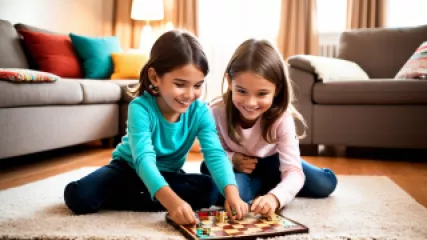Why I Believe These Tips for Handling Sibling Conflict Work Best
As someone who has both experienced sibling rivalry firsthand and worked with numerous families through various sibling coaching services, I believe I have a unique perspective on the best tips for handling sibling conflict. Sibling relationships are some of the most formative in our lives, shaping how we interact with others and understand ourselves. However, they can also be fraught with conflict and competition. In this opinion piece, I will share why I believe certain strategies work best for resolving sibling conflicts and fostering healthier sibling relationships.
The Importance of Understanding Sibling Dynamics
Before diving into specific tips, it's crucial to understand the dynamics that often underlie sibling conflict. Sibling rivalry can stem from a variety of sources, including competition for parental attention, differences in personality or interests, and external stressors. Recognizing these factors can help parents and caregivers address conflicts more effectively.
- Competition for Attention: Children often vie for their parents' attention, which can lead to jealousy and resentment. This is especially true in families where one child may require more attention due to age, health issues, or special needs.
- Personality Clashes: Just like adults, children have different temperaments and personalities. These differences can lead to misunderstandings and conflicts if not managed properly.
- External Stressors: Factors such as moving to a new home, changes in family structure, or academic pressures can exacerbate sibling conflicts.
The Role of Parental Influence
One of the most significant influences on sibling relationships is parental behavior. Parents set the tone for how conflicts are managed and resolved within the family. Here are some key ways parents can positively influence sibling dynamics:
- Modeling Positive Behavior: Children learn by observing their parents. Demonstrating healthy conflict resolution skills, such as active listening and empathy, can teach children how to handle disagreements constructively.
- Setting Clear Boundaries: Establishing rules and expectations for behavior can help prevent conflicts from escalating. For example, parents can implement a rule that physical aggression is never acceptable.
- Encouraging Individuality: Celebrating each child's unique strengths and interests can reduce feelings of competition and jealousy.
Effective Communication: The Foundation of Resolution
Effective communication is the cornerstone of resolving any conflict, including sibling disputes. Here are some tips for fostering open and respectful communication between siblings:
- Active Listening: Encourage children to listen to each other without interrupting. This helps them understand each other's perspectives and feelings.
- Use "I" Statements: Teach children to express their feelings using "I" statements, such as "I feel upset when you take my toys without asking." This reduces blame and encourages constructive dialogue.
- Mediation: Sometimes, a neutral third party, such as a parent or sibling coach, can help mediate conflicts and facilitate productive conversations.
The Power of Empathy
Empathy is a powerful tool for resolving conflicts and building stronger sibling relationships. When children learn to understand and share their siblings' feelings, they are more likely to resolve disputes amicably. Here are some strategies for fostering empathy:
- Perspective-Taking Exercises: Encourage children to put themselves in their siblings' shoes. Ask questions like, "How would you feel if someone did that to you?"
- Reading Books and Stories: Stories about characters experiencing similar conflicts can help children develop empathy and understanding.
- Role-Playing: Role-playing different scenarios can help children practice empathizing with each other and finding solutions to conflicts.
Creating Opportunities for Positive Interactions
While conflict is inevitable, providing opportunities for positive interactions can strengthen sibling bonds and reduce the frequency of disputes. Some ways to encourage positive interactions include:
- Shared Activities: Encourage siblings to participate in activities they both enjoy, such as playing games, doing crafts, or going on outings.
- Teamwork: Assign tasks that require cooperation and teamwork, such as cleaning up together or working on a project.
- Celebrating Achievements: Celebrate each child's achievements and milestones together as a family. This fosters a sense of shared joy and pride.
The Role of Consistency and Routine
Consistency and routine play a vital role in reducing sibling conflicts. When children know what to expect and understand the family's routines and rules, they are less likely to engage in power struggles and conflicts. Here are some ways to implement consistency and routine:
- Establishing Daily Routines: Having consistent daily routines, such as meal times, bedtimes, and homework times, provides structure and predictability.
- Consistent Discipline: Applying consistent consequences for negative behavior helps children understand the boundaries and reduces the likelihood of repeated conflicts.
- Family Meetings: Regular family meetings provide a platform for discussing issues, setting goals, and reinforcing family values and rules.
Individual Attention and One-on-One Time
Providing individual attention and one-on-one time with each child can significantly reduce feelings of competition and jealousy. When children feel valued and heard, they are less likely to engage in negative behaviors to seek attention. Here are some tips for providing individual attention:
- Dedicated Time: Schedule regular one-on-one time with each child to engage in activities they enjoy. This can be as simple as reading a book together or going for a walk.
- Listening: Take the time to listen to each child's thoughts and feelings without distractions. This shows them that their opinions matter.
- Personalized Praise: Offer specific and personalized praise for each child's accomplishments and efforts. This reinforces their unique strengths and contributions.
Recognizing and Addressing Underlying Issues
Sometimes, sibling conflicts are a symptom of underlying issues that need to be addressed. Identifying and addressing these issues can lead to more lasting resolutions. Some common underlying issues include:
- Unresolved Emotions: Children may act out due to unresolved emotions such as anger, sadness, or anxiety. Providing a safe space for them to express their feelings can help alleviate conflicts.
- Developmental Stages: Understanding the developmental stages of each child can help parents tailor their approaches to conflict resolution. For example, younger children may need more guidance and support in managing their emotions.
- External Stressors: Addressing external stressors, such as academic pressures or changes in family dynamics, can reduce the overall stress levels and improve sibling relationships.
The Benefits of Professional Support
In some cases, seeking professional support from sibling coaching services or family therapists can be beneficial. These professionals can provide tailored strategies and support for resolving conflicts and improving sibling relationships. Here are some benefits of professional support:
- Expert Guidance: Professionals have the expertise to identify underlying issues and provide effective strategies for resolution.
- Neutral Perspective: A neutral third party can offer an unbiased perspective and mediate conflicts more effectively.
- Ongoing Support: Professional support can provide ongoing guidance and resources to help families navigate challenges and maintain positive relationships.
Conclusion: Building Stronger Sibling Relationships
In conclusion, resolving sibling conflicts and building stronger sibling relationships requires a multifaceted approach. By understanding the dynamics of sibling relationships, modeling positive behavior, fostering effective communication, and providing individual attention, parents can create a supportive environment that reduces conflicts and strengthens bonds. Additionally, recognizing and addressing underlying issues and seeking professional support when needed can lead to more lasting and meaningful resolutions. Ultimately, the goal is to help siblings develop the skills and empathy needed to navigate conflicts and build lifelong, positive relationships.
"The bond that links your true family is not one of blood, but of respect and joy in each other's life." Richard Bach
I believe that these tips for handling sibling conflict work best because they address the root causes of conflict and provide practical strategies for resolution. By implementing these tips, families can create a harmonious and supportive environment where siblings can thrive and grow together.
However, it's important to remember that every family is unique, and what works for one family may not work for another. It's essential to be flexible and adapt these strategies to fit the specific needs and dynamics of your family. With patience, consistency, and a commitment to fostering positive relationships, parents can help their children navigate conflicts and build strong, lasting bonds.
I hope that these insights and tips will provide valuable guidance for families seeking to improve their sibling relationships and create a more harmonious home environment. Remember, the journey to building strong sibling relationships is a continuous process, and every step taken towards understanding and empathy brings us closer to a more peaceful and loving family dynamic.






